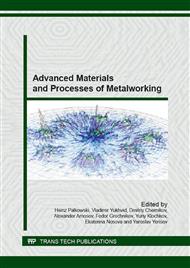[1]
S.A. Valiev. Combined deep drawing of sheet material. M.: Engineering, 1973, 176 pp.
Google Scholar
[2]
S.P. Yakovlev , S.S. Yakovlev, V.A. Andreichenko. Forming of anisotropic materials. Kishinev: Quant. 1997. 331 p.
Google Scholar
[3]
S.S. Yakovlev, V.D. Kuhar, V.I. Tregubov. Theory and technology of stamping anisotropic materials / ed. By S.S. Yakovlev. M .: Engineering, 2012. 400 pp.
Google Scholar
[4]
Forging and stamping. Reference-book in 4 vv. V. 4. Sheet stamping. /General editing by S.S. Yakovlev. Editorial board: Ye.I. Semyonov (chairman) and others. 2-nd edition, revised and expanded. M., Engineering, 2010. 732 pp.
Google Scholar
[5]
Isothermal straining of highly strong anisotropic metals/S.P. Yakovlev , V.N. Chudin, S.S. Yakovlev, Ya.A. Sobolev, M., Engineering, 2004. 427 pp.
Google Scholar
[6]
Isothermal deformation of anisotropic materials with blunt tools in mode of short-term creep / S.S. Yakovlev, S.P. Yakovlev, V.N. Chudin, V.I. Tregubov, A.V. Chernyaev. M .: Engineering, 2009. 412 pp.
Google Scholar
[7]
N.N. Malinin. Creep in processing of metals. M .: Engineering, 1986. 216 pp.
Google Scholar
[8]
E.A. Popov, V.G. Kovalev, I.N. Shubin. Technology and automation of sheet stamping. M .: Publishing House of the MSTU of N.E. Bauman, 2000. 480 pp.
Google Scholar
[9]
V.L. Kolmogorov . Mechanics of Metal Forming. Yekaterinburg: Ural State Technical University (UPI), 2001. 836 p.
Google Scholar
[10]
A.A. Bogatov . Mechanical properties and fracture models of metals. Yekaterinburg: SEI HPE Ural State Technical University, 2002. 329 pp.
Google Scholar
[11]
K. Bandyopadhyaya, S.K. Pandaa, P. Sahaa, G. Padmanabhamb Limiting drawing ratio and deep drawing behavior of dual phase steel tailor welded blanks: FE simulation and experimental validation / Journal of Materials Processing Technology. Volume 217, March 2015, Pages 48–64.
DOI: 10.1016/j.jmatprotec.2014.10.022
Google Scholar
[12]
Ho Seon Jooa, Sun Kwang Hwangb, Hyun Moo Baeka, Yong-Taek Ima, Il-Heon Sond, Chul Min Baed The effect of a non-circular drawing sequence on spheroidization of medium carbon steel wires / Journal of Materials Processing Technology. Volume 216, February 2015, Pages 348–356.
DOI: 10.1016/j.jmatprotec.2014.10.001
Google Scholar
[13]
Improvement of formability in deep drawing of ultra-high strength steel sheets by coating of die / Journal of Materials Processing Technology. Volume 214, Issue 9, September 2014, Pages 1838–1843.
DOI: 10.1016/j.jmatprotec.2014.03.023
Google Scholar
[14]
M.W. Fu, B. Yang, W.L. Chan Experimental and simulation studies of micro blanking and deep drawing compound process using copper sheet / Journal of Materials Processing Technology. Volume 213, Issue 1, January 2013, Pages 101–110.
DOI: 10.1016/j.jmatprotec.2012.08.007
Google Scholar
[15]
S. Thuilliera, P.Y. Manacha, L.F. Menezesb Occurence of strain path changes in a two-stage deep drawing process / Journal of Materials Processing Technology. Volume 210, Issue 2, 19 January 2010, Pages 226–232.
DOI: 10.1016/j.jmatprotec.2009.09.004
Google Scholar
[16]
Kenji Tamaokia, Ken-ichi Manabeb, Seiji Kataokac, Tatsuhiko Aizawad Electroconductive ceramic tooling for dry deep drawing / Journal of Materials Processing Technology. Volume 210, Issue 1, 1 January 2010, Pages 48–53.
DOI: 10.1016/j.jmatprotec.2009.08.020
Google Scholar
[17]
Zhiyuan Zhanga, Shengdun Zhaob, Yong Zhangb A novel response variable for finite element simulation of hydro-mechanical deep drawing / Journal of Materials Processing Technology. Volume 208, Issues 1–3, 21 November 2008, Pages 85–89.
DOI: 10.1016/j.jmatprotec.2007.12.129
Google Scholar


